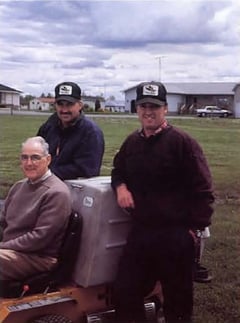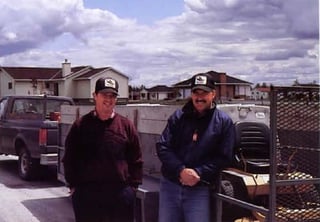"I felt the ground begin to tremble and I realized too late that an ocean-going ship had caught me off guard. By the time I looked around it was right next to me. I could have reached out and touched it. It really gave me a fright. " So recounts Francie Keeler about one of her recent experiences working in the family business Dandy Lawn.Eight years ago, she and husband Roy were operating a turkey farm near Quebec City. Mowing grass and ocean-going ships were the furthest things from their mind. Maintaining top billing, instead, was a newly imposed government quota system on turkey farmers.
 A couple hundred miles to the south, Roy's father Winston "Wink" was retiring from teaching. Looking for a way to stay active, he thought the lawn maintenance business had potential. He introduced Roy to the idea - and a business was born.
A couple hundred miles to the south, Roy's father Winston "Wink" was retiring from teaching. Looking for a way to stay active, he thought the lawn maintenance business had potential. He introduced Roy to the idea - and a business was born.
Roy and his wife, Francie, sold the farm and moved back to Lancaster (on the New York, Canada border) and started pounding doors. That was in 1986. As Wink remembers, his son had no pattern to follow. "We were really pioneering a new industry. Canada is a little ways behind the States when it comes to landscaping."
Wink, working in the business more as a consultant than an employee, and his son struggled through the first full season. By the end of 1986, Dandy Lawn had 35 commercial and residential accounts. A good start but not enough to support a family. A year later, Roy added a new out-front rider and was able to grow more accounts. Equipment downtime and a tough labor market, however, quickly put a cap on further growth. Roy needed a shot in the arm and Wink found it.
An avid reader, Wink saw the Walker mower advertised in Organic Gardening magazine. His first call to Fort Collins was a disappointment. He could buy a Walker, but the company had no distribution in Canada. Service and parts would have to be trusted to long distance. A second call a year later put him in touch with new Walker distributor P.E. Schneider Ltd. in Lakeside, Ontario. "Percy gave us a demo, " recalls Roy, "and he never put the mower back on his trailer."
The new Walker purchase in 1988 marked a milestone in the young company's history. Dandy Lawn said adieu to the old rider - although they will still use it in an emergency- and the company welcomed Roy's brother Dick.
The combination was just what the doctor ordered. Roy had a degree in general agriculture and Dick a diploma with a major in horticulture. They knew turf and they knew how to maintain it. With a new Walker, they had a machine that could put in a full day's work, day after day. And it seemed the perfect fit for their customers - owners of small family homes, apartment complexes, even cemeteries. The Walker moved in and around obstacles and over mounds with dexterity, without leaving behind scalp marks. A low profile allowed the mower to work the hills without tipping.
Dandy Lawn grew and so did its relationship with Walker. The company purchased another 16-hp, gear drive Walker in 1989, two in 1990, and one each, every year since. Today, Dandy Lawn personnel operate seven Walkers, including the one they purchased the first year. And the original unit has more than 2, 200 hours on it.
Dandy Lawn has 250 residential and commercial accounts. Four crews mow upward of about 300 acres a week, from small, 2, 000-square-foot areas to 23-acre jobs. Except for 10 small properties and a couple of spacious, hilly projects, the Walkers do nearly all of the mowing, with more than a little help from the Keeler family.
 In fact, the Keeler name rings prominent throughout the entire organization. ln addition to Roy, Dick, Wink and Francie, who does the estimating and plantings, Roy's three offspring - Cory, Leigh and Lori - and Dick's two - Denise and Tawyna - can be found on any given day operating a Walker or holding a string trimmer. Non-Keelers Sue McDonald, Thornton Westley, Chris Page and AI Lalonde round out the crew.
In fact, the Keeler name rings prominent throughout the entire organization. ln addition to Roy, Dick, Wink and Francie, who does the estimating and plantings, Roy's three offspring - Cory, Leigh and Lori - and Dick's two - Denise and Tawyna - can be found on any given day operating a Walker or holding a string trimmer. Non-Keelers Sue McDonald, Thornton Westley, Chris Page and AI Lalonde round out the crew.
Natural Obstacles
Dandy Lawn is headquartered in Lancaster, Ontario, very close to the Ontario/Quebec border. Lancaster is approximately 60 miles west of Montreal and 280 miles east of Toronto. The company has clients in a 20-mile radius from the city, which frequently takes crews across the border into Quebec. Wink claims the media overstates the rivalry between the two provinces, yet governing laws make doing business in both a challenge. For example, Dandy Lawn is licensed to spray weeds in Ontario, but not in Quebec. And trucks are frequently stopped crossing the border to ensure they have the proper permits.
Just like environs everywhere, other challenges prevail. This spring, Mother Nature forgot to turn off the faucet. Sixty- and 70-hour, six-day weeks were hardly enough to keep crews on schedule. Late spring also brought out "shad" flies that inhabit the river country around the St. Lawrence Seaway. They don't bite, but they sure fill up the air with their long bodies and wings.
Then there are man-made obstacles like the ship Francie encountered. Several Dandy Lawn accounts have property that borders the St. Lawrence Seaway. Ocean-going vessels are a common site and less startling when you see them coming. The tracks of a fast-moving train that connects Montreal and Toronto cross one of Dandy Lawn's properties. "If you don't see it coming, the blast of the hom will take a year off your life," relates Dick.
 Growth Patterns
Growth Patterns
Roy and Dick looked to grow slowly, returning profits to the business to sustain the growth. ln eight short years, they have compiled an inventory worth about $200,000. ln addition to the Walkers, the lineup includes a Kubota out-front mower, a couple of Lawn-Boy hand mowers, a full complement of trimmers, edgers and sprayers, plus a fleet of pickups and trailers. The Walkers are their biggest investment by far, however. Each has two decks; a side discharge and a bagging deck. Two crews with four Walkers bag, the other crews side discharge. Decks are changed when crews pitch in to help each other. "It only takes a couple of minutes to switch decks," Dick points out. He figures each Walker accounts for 30 properties a week.
Growth has slowed, despite the brothers' uncanny ability to maintain clients. In fact, with a hint of fatherly pride, Wink claims Dandy Lawn has yet to lose an account due to poor work practices. Yet there's a limit to how big a company can get and still find good employees to run the equipment.
Over the years, the company has targeted private homes as its growth area, getting away from large commercial and municipal properties. The latter, which are referred to as tenders, are just too competitive, notes Wink. Dandy Lawn is competing with smaller contractors who may not provide their employees with some of the social benefits. To stay competitive, Dandy Lawn relies on quality work and high volume. The company signs yearly contracts and bills seven times a year, from May 1 to November 1. Eighty-five percent of the customers pay by the 15th of each month, Wink relates.
Unlike many contractors, Dandy Lawn doesn't remove snow in the winter. Time is well-spent keeping equipment in good repair, notes Roy.
Dandy Lawn faces the same challenge all pioneers over the centuries have faced, increasing competition. The first to use Walkers in the area, they are now seeing competitors with the units. The nice thing - while a Walker can make you more competitive, it doesn't do the job by itself. And few operators have the wherewithal and togetherness to do it as efficiently and effectively as the Keelers.




 Site Search
Site Search



